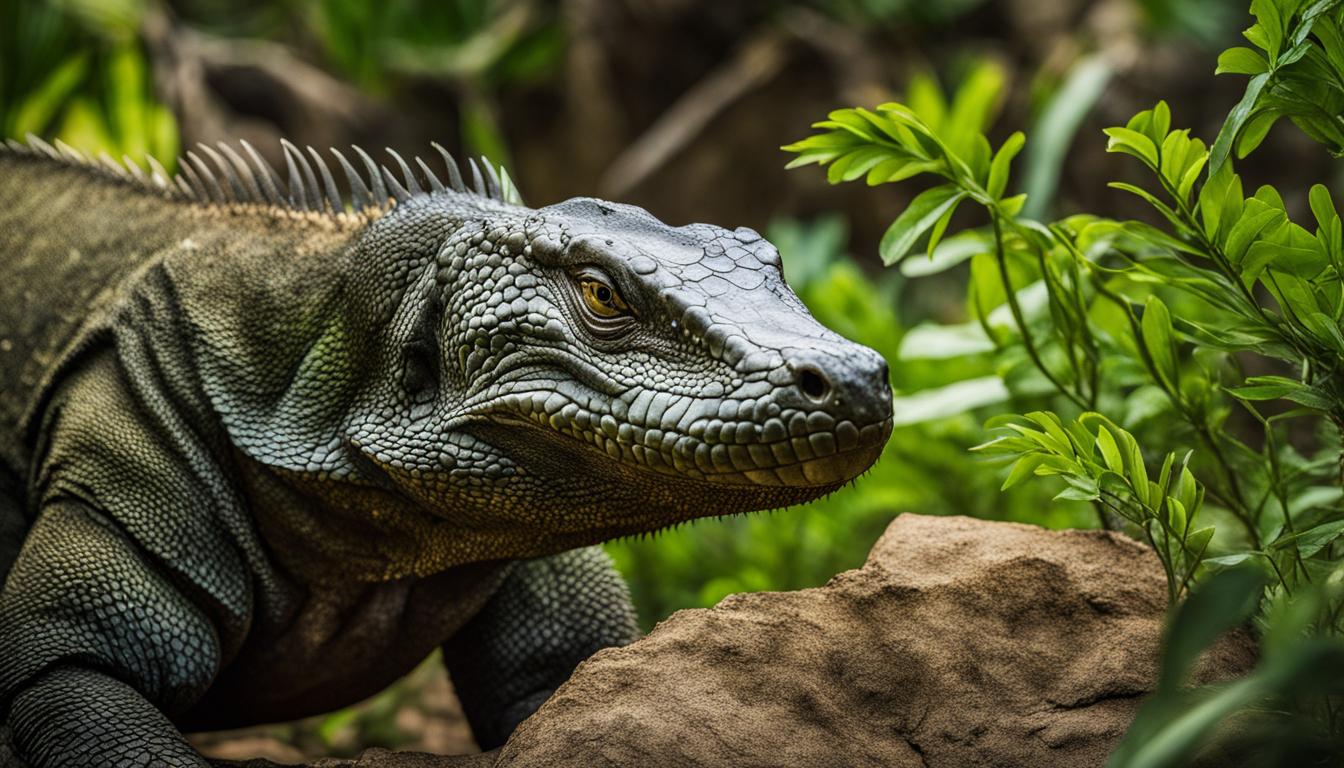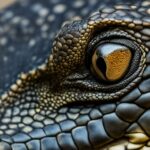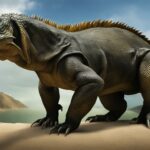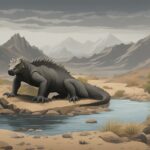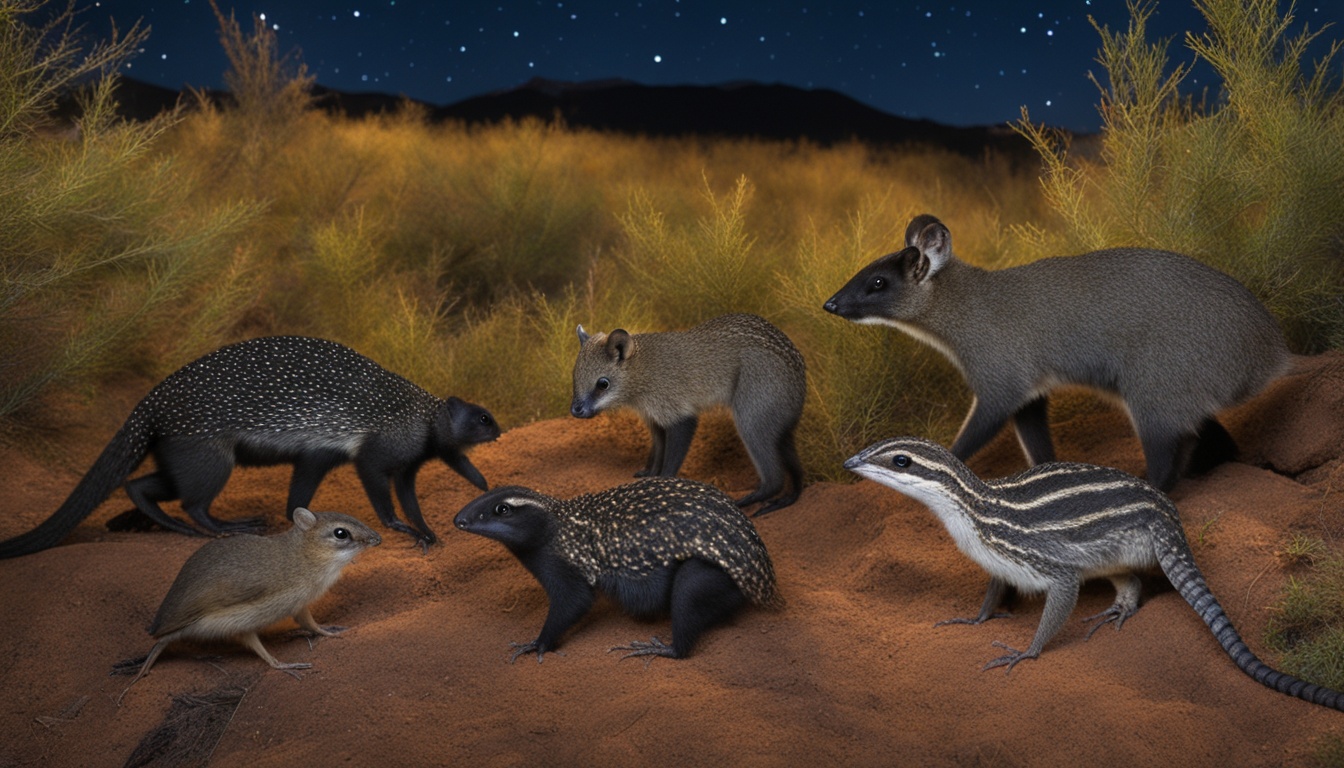Welcome to an exciting journey where you’ll uncover the wonders of the world’s largest lizard – the Komodo Dragon. Found exclusively in the stunning landscapes of Indonesia, this magnificent reptile, scientifically known as Varanus komodoensis, is truly a sight to behold. Join us as we delve into the captivating realm of these giant monitor lizards and discover fascinating facts about their size, habitat, diet, and reproduction.
As you embark on this virtual expedition, you’ll not only learn about the intriguing characteristics of Komodo Dragons but also gain insights into the importance of wildlife conservation. Explore the enchanting world of Komodo National Park, where these majestic creatures find refuge and discover the efforts being made to protect this endangered species.
So, get ready to be captivated by the wonders of the Komodo Dragon – a true marvel of nature. Let’s dive into the enthralling realm of reptiles and uncover the secrets of this unique and awe-inspiring creature together.
The Habitat of Komodo Dragons
The Komodo dragon, known as Varanus komodoensis, is a fascinating reptile that can be found in its natural habitat on the Lesser Sunda Islands of Indonesia. These islands are located in the eastern part of the country and are characterized by their tropical forests. The Komodo dragon has adapted to thrive in this unique environment, which provides it with the ideal conditions for survival.
These reptiles prefer the shelter of the tropical forests but can also be found in a variety of other habitats across the islands. Despite their ability to walk up to seven miles per day, Komodo dragons tend to stay close to their hatching valleys and rarely venture far from home. This behavior ensures that they have a familiar territory to navigate and reduces the risks associated with encountering unfamiliar environments.
The tropical forests of the Lesser Sunda Islands offer a diverse range of food sources for the Komodo dragons, including prey such as smaller dragons, deer, pigs, carrion, and even large water buffalo. The dense vegetation provides the dragons with ample cover to hide and ambush their prey, making these forests an ideal habitat for their hunting and feeding behaviors.
The Habitat of Komodo Dragons
| Habitat | Location | Characteristics |
|---|---|---|
| Tropical Forests | Lesser Sunda Islands | Lush vegetation, ample food sources, ideal hunting grounds |
| Hatching Valleys | Close proximity to home | Safe and familiar territory for navigation |
| Other Habitats | Variety of environments | Adaptability to different conditions |
Overall, the habitat of Komodo dragons in the tropical forests of the Lesser Sunda Islands provides them with the necessary resources for survival. The dense vegetation, abundant prey, and familiar territories contribute to the success and resilience of these fascinating reptiles.
Image source: https://seo-writing.ai/32_6.png
Reproduction of Komodo Dragons
Komodo dragons have a fascinating reproductive process that involves mating, egg-laying, and even the ability to reproduce asexually. Female Komodo dragons mate once a year when they are ready to reproduce. To attract males, they release a scent in their feces. When a male dragon detects this scent, he initiates the mating process by scratching the female’s back and licking her body. If the female responds by licking him back, they mate.
Males sometimes engage in wrestling matches to compete for the right to mate with a female. Once a female is pregnant, she will lay around 30 eggs, which she buries in the ground to keep them safe. The incubation period for the eggs is approximately eight months.
What makes Komodo dragons even more intriguing is the phenomenon of parthenogenesis. In the absence of males, female Komodo dragons have the remarkable ability to reproduce asexually. They can produce viable offspring without mating through a process called parthenogenesis. This adaptation ensures that the species can continue to survive even in situations where males are scarce. Parthenogenesis in Komodo dragons is a rare occurrence in the animal kingdom and adds to the uniqueness of these remarkable creatures.
Reproduction of Komodo Dragons: Key Points
- Female Komodo dragons mate once a year and emit a scent in their feces to attract males.
- Males initiate mating by scratching the female’s back and licking her body.
- Females lay around 30 eggs, burying them in the ground for protection.
- Parthenogenesis is the ability of female Komodo dragons to reproduce asexually in the absence of males.
The reproductive behavior and adaptations of Komodo dragons provide insight into their evolutionary success and the strategies they employ to ensure their survival as a species.
The Diet of Komodo Dragons
Komodo dragons are fascinating creatures with unique dietary habits. As carnivorous predators, they have a diverse diet that includes various animals found in their habitat. These lizards are known for their ability to ambush and overpower their prey, making them formidable hunters.
Komodo Dragon Diet
The diet of Komodo dragons consists of carrion, deer, pigs, smaller dragons, and even large water buffalo. They are opportunistic feeders and will consume almost anything they come across. Their ability to eat such a wide range of prey contributes to their survival and dominance as apex predators in their ecosystem.
With their excellent camouflage and patience, Komodo dragons lie in wait for their unsuspecting prey. When an opportunity arises, they use their sharp claws and serrated teeth to subdue and eviscerate their victims. Their specialized hunting techniques allow them to efficiently consume their prey.
The Komodo dragon’s diet is a key aspect of its survival and plays a crucial role in maintaining the balance of its ecosystem.
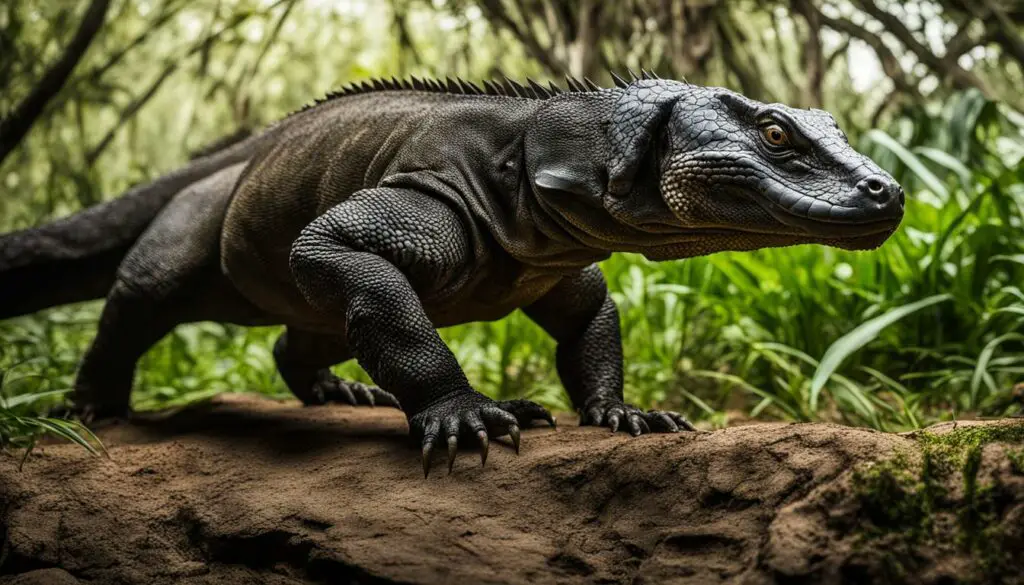
Table: Comparison of Prey Consumed by Komodo Dragons
| Prey Type | Examples |
|---|---|
| Carrion | Dead animals, including large mammals and reptiles |
| Deer | Wild deer species native to the Komodo dragon’s habitat |
| Pigs | Wild boars and other pig species |
| Smaller Dragons | Young or weaker Komodo dragons that fall prey to their larger counterparts |
| Large Water Buffalo | Buffalos found in the same habitat as Komodo dragons |
The table above showcases the diverse range of prey that Komodo dragons feed on. Their ability to consume such varied and sometimes large animals highlights their adaptability and success as predators.
Did you know? Komodo dragons can consume up to 80 percent of their body weight in a single feeding!
The unique hunting and feeding behaviors of Komodo dragons make them truly fascinating creatures. Their diet and hunting methods contribute to the delicate balance of their ecosystem and showcase the importance of their conservation.
Feeding Behavior of Komodo Dragons
When it comes to feeding, Komodo dragons have a unique and fascinating behavior. These mighty creatures rely not only on their strength but also on their venomous bite to immobilize and bring down their prey.
“The Komodo dragon’s venom glands are loaded with toxins that can cause massive bleeding, prevent clotting, and induce shock,” explains Dr. Jane Peterson, a wildlife biologist specializing in reptiles. “When a Komodo dragon bites its prey, the venom quickly takes effect, accelerating blood loss and sending the victim into shock.”
Even if the prey manages to escape, the dragon can follow the scent of the dying or dead animal. This incredible ability to track down wounded prey makes the Komodo dragon a formidable predator in its habitat.
Feeding Habits and Consumption
Komodo dragons have a remarkable capacity for consumption. In fact, they can consume up to 80 percent of their body weight in a single feeding. This means that a fully grown Komodo dragon weighing around 330 pounds can devour up to 264 pounds of flesh in one meal. Their sharp claws and serrated teeth enable them to tear through the tough hide and flesh of their prey.
| Type of Prey | Prey Size | Feeding Time |
|---|---|---|
| Small Mammals | Deer, pigs | 30 minutes to 1 hour |
| Large Prey | Water buffalo | 1 to 2 hours |
According to Dr. Peterson, “Once a Komodo dragon has successfully brought down its prey, it will tear through the flesh and consume the meat. The bones and tough parts are often crushed and swallowed, as the dragons possess powerful digestive enzymes that can break down even the toughest materials.”
It’s important to note that while Komodo dragons are formidable predators, they also play a crucial role in their ecosystem. As apex predators, they help maintain balance and regulate populations of other species within their habitat.
Threats to the Survival of Komodo Dragons
Komodo dragons, the world’s largest lizards, face numerous threats that put their survival at risk. The destruction of their natural habitat is a major concern. Due to burning and clearing for various purposes, the Komodo dragon’s tropical forest home is diminishing rapidly. This habitat loss not only disrupts their way of life but also affects the fragile ecosystems they are a part of.
Another significant threat to Komodo dragons is poaching. These endangered animals are illegally traded, along with their prey, exacerbating their population decline. The demand for exotic pets and traditional medicine drives this illegal trade. The relentless pursuit of profit at the expense of these magnificent creatures jeopardizes their long-term survival.
“The destruction of their natural habitat and their illegal trade are major threats to the survival of Komodo dragons.”
Human activities also contribute to the challenges faced by Komodo dragons. Disrupting their mating process by offering food handouts, for example, interferes with their natural behaviors. Such interventions can lead to a decline in reproductive success and genetic diversity. Additionally, the small population of female dragons and inbreeding further compounds the threats faced by this endangered species.
Table: Threats to the Survival of Komodo Dragons
| Threat | Description |
|---|---|
| Habitat Destruction | The destruction of their tropical forest habitat due to burning and clearing for various purposes. |
| Poaching | The illegal trade of Komodo dragons and their prey, driven by the demand for exotic pets and traditional medicine. |
| Human Activities | Disrupting their mating process and genetic diversity through interventions such as offering food handouts and inbreeding. |
Efforts are needed to address these threats and ensure the long-term survival of Komodo dragons. Conservation initiatives, such as raising awareness, implementing stricter regulations against poaching, and restoring their natural habitats, are crucial. Collaboration between governments, local communities, and conservation organizations is key to protecting these iconic lizard species and preserving the biodiversity of their ecosystems.
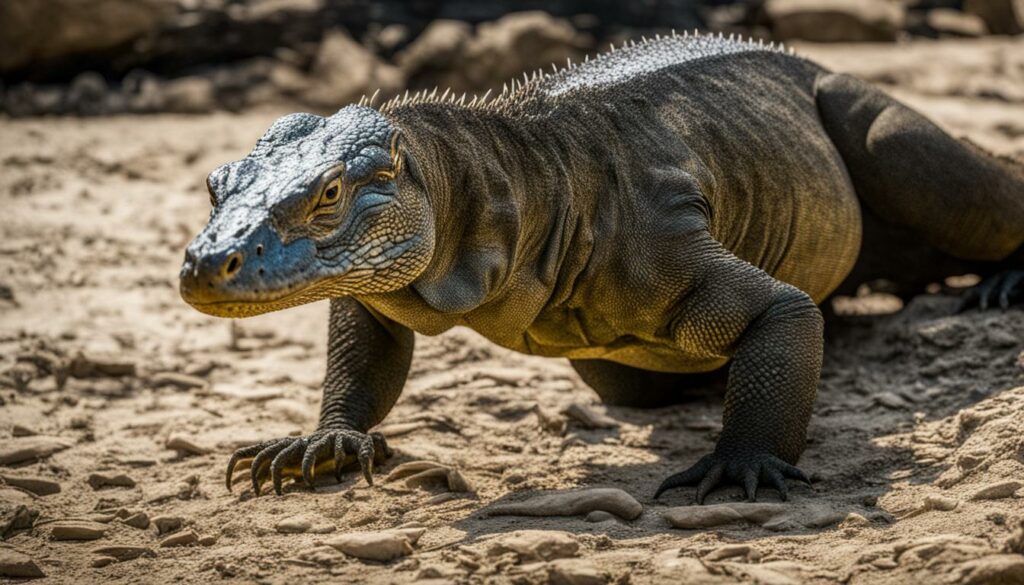
Conservation Efforts for Komodo Dragons
Conservation efforts for Komodo dragons have been crucial in protecting this iconic species and preserving their natural habitat. One significant initiative in place is the establishment of Komodo National Park in 1980, covering an area of 700 square miles. This park serves as a sanctuary for the Komodo dragon and various other species, contributing to the overall biodiversity conservation in the region.
Within the park, wildlife protection and conservation measures are implemented through regular patrolling to prevent poaching and illegal trade. These efforts are supported by raising awareness among local communities about the importance of protecting the species and their habitat. By involving the local population, the conservation efforts gain momentum and create a sense of responsibility and ownership.
The conservation of Komodo dragons is also aided by the sustainable tourism practices in Komodo National Park. Tourism provides economic incentives for the locals, encouraging them to actively participate in protecting the species and their environment. It offers visitors an opportunity to observe these magnificent creatures in their natural habitat while generating revenue that can be invested in conservation programs.
The collective efforts of conservation organizations, government agencies, and local communities are crucial in preserving the Komodo dragon population and ensuring their long-term survival. By continuing to prioritize wildlife protection and habitat preservation, we can secure a future where Komodo dragons thrive in their natural ecosystem.
Komodo Dragon Facts and Discovery
There is no denying the intrigue surrounding Komodo dragons. These fascinating creatures have captivated researchers and scientists for decades. Let’s dive into some intriguing details and scientific studies that have shed light on the behavior, reproduction, feeding habits, and unique adaptations of these incredible lizards.
Scientific study and exploration of Komodo dragons began roughly a century ago, leading to the discovery of many remarkable facts. Researchers have uncovered details about their impressive size, with the largest individuals reaching up to 10 feet in length and weighing around 330 pounds. Their sheer size makes them the heaviest lizards on Earth. In addition to their size, Komodo dragons possess venom glands loaded with toxins that aid in hunting and capturing prey, making them formidable predators.
Furthermore, female Komodo dragons have a remarkable reproductive ability known as parthenogenesis. This process allows them to reproduce asexually in the absence of males. While mating usually occurs between males and females, this unique adaptation ensures that females can sustain the population even in extreme circumstances.
“The discovery of these fascinating creatures has intrigued researchers and led to a deeper understanding of their behavior, reproduction, feeding habits, and unique evolutionary adaptations.”
Through extensive scientific study, we have gained valuable insights into the lives of Komodo dragons. These findings have served to increase our understanding and appreciation for these ancient reptiles. As research continues, we can expect even more fascinating discoveries that will further contribute to the conservation and protection of these magnificent creatures.
Unique Characteristics of Komodo Dragons
Komodo dragons possess several unique characteristics that make them stand out among other lizard species. From their impressive size and weight to their venomous bite and remarkable adaptations, these creatures are truly one-of-a-kind.
First and foremost, Komodo dragons are the largest lizards on Earth, reaching lengths of up to 10 feet and weighing around 330 pounds. Their massive size sets them apart from all other lizard species and contributes to their dominant presence in their natural habitat.
Another remarkable characteristic of Komodo dragons is their venomous bite. These lizards have glands loaded with toxins in their mouths, which are used to immobilize their prey. When a Komodo dragon bites down on its victim, the venom quickly takes effect, causing massive bleeding, preventing clotting, and inducing shock. This venomous adaptation aids in capturing and overpowering prey.
| Unique Characteristics of Komodo Dragons | |
|---|---|
| Size | Komodo dragons can grow up to 10 feet in length and weigh around 330 pounds, making them the largest lizards in the world. |
| Weight | With their impressive size, Komodo dragons can weigh as much as 330 pounds, making them the heaviest lizards on Earth. |
| Venom | Komodo dragons possess venom glands in their mouths that aid in hunting and capturing prey, causing massive bleeding and inducing shock. |
| Adaptations | These lizards have adapted to their environment with features such as sharp claws, serrated teeth, and excellent camouflage for ambushing prey. |
“Komodo dragons possess unique characteristics that set them apart from other lizards. From their impressive size and weight to their venomous bite and remarkable adaptations, they are truly fascinating creatures.”
Lastly, Komodo dragons have adapted to their environment in various ways. They have sharp claws and serrated teeth that are perfectly designed for capturing and eviscerating prey. Their excellent camouflage allows them to blend seamlessly into their surroundings, making them highly effective ambush predators.
In conclusion, the unique characteristics of Komodo dragons, including their size, weight, venomous bite, and adaptations, make them truly extraordinary creatures. Their impressive features contribute to their dominance as the largest lizards on Earth and their success as apex predators in their habitats.
Endangered Status of Komodo Dragons
The Komodo dragon, one of the most remarkable reptiles on Earth, is currently listed as an endangered species. Their population is considered stable and at low risk from hunting; however, they face imminent threats due to habitat loss caused by climate change. Rising sea levels pose a significant danger to their natural habitat in the Lesser Sunda Islands of Indonesia.
The International Union for Conservation of Nature (IUCN) lists the Komodo dragon as endangered, highlighting the urgent need for conservation efforts. Habitat loss is a critical factor contributing to their vulnerable status. Climate change impacts, such as sea-level rise and extreme weather events, pose a significant risk to the survival of these magnificent creatures.
Educational programs, research initiatives, and conservation projects are crucial in protecting and preserving the remaining Komodo dragon population. Efforts to raise awareness about the species’ endangered status and the importance of habitat conservation are essential components of these initiatives. Furthermore, promoting sustainable ecotourism can provide economic incentives for local communities to support conservation efforts and ensure the long-term survival of the Komodo dragon.
The Threats to Komodo Dragons
The Komodo dragon faces several threats, primarily habitat loss due to climate change and human activities. Rising sea levels pose a significant risk to their nesting grounds and hunting areas. This, combined with illegal poaching and the destruction of their habitat, puts the species in a critical position. To safeguard the future of these iconic lizards, immediate conservation measures and sustainable practices are essential.
Ecotourism and Conservation
Ecotourism has the potential to play a vital role in the conservation of Komodo dragons. Responsible tourism practices can generate income for local communities and create incentives for protecting the species and their habitat. By promoting sustainable tourism, implementing strict regulations, and raising awareness among visitors, we can contribute to the conservation of the Komodo dragon while also supporting the local economy.
Importance of Komodo National Park
Komodo National Park is a site of immense importance for the conservation of biodiversity, particularly for the iconic Komodo dragon. This protected area, situated in the Lesser Sunda Islands of Indonesia, encompasses a range of unique ecosystems, including tropical forests and marine habitats. Its significance goes beyond the preservation of the world’s largest lizard species, as it is also home to a diverse array of flora and fauna.
The park serves as a model for wildlife conservation, demonstrating the importance of preserving natural habitats and safeguarding endangered species. Through collaborative efforts with local communities and conservation organizations, Komodo National Park has successfully raised awareness about the need for biodiversity conservation. Its establishment in 1980 was a crucial step in protecting the Komodo dragon and its habitat from various threats.
The presence of the Komodo dragon in the park not only draws attention to the species itself but also attracts visitors from around the world. This influx of tourists provides economic incentives for local communities to actively participate in wildlife protection efforts. The revenue generated from ecotourism plays a vital role in supporting conservation initiatives, ensuring the long-term sustainability of the park and its biodiversity.
Komodo National Park – Key Facts
| Location | Lesser Sunda Islands, Indonesia |
|---|---|
| Size | 700 square miles |
| Established | 1980 |
| Species | Komodo dragon and various flora and fauna |
| Conservation Efforts | Collaboration with local communities, patrolling to prevent poaching, raising awareness through tourism |
“Komodo National Park showcases the delicate balance between nature and human existence. It provides a sanctuary for the Komodo dragon and other endangered species, enabling them to thrive in their natural habitat. This park serves as a reminder of the importance of conservation and sustainable practices in safeguarding our planet’s biodiversity for future generations.”
Through its efforts in safeguarding the Komodo dragon and preserving its habitat, Komodo National Park plays a vital role in global biodiversity conservation. By recognizing and protecting the significance of this unique ecosystem, we can contribute to the long-term survival of not only the Komodo dragon but also various other species that call this park home. It is imperative that we continue to support and promote the conservation efforts at Komodo National Park to ensure the preservation of this remarkable natural heritage.
Conclusion
The Komodo dragon, the world’s largest lizard, is a marvel of nature that has captivated researchers and conservationists alike. With its impressive size, diverse diet, and unique reproductive abilities, this iconic species is a testament to the wonders of wildlife.
However, the Komodo dragon faces numerous challenges to its survival, including habitat loss, poaching, and the impacts of climate change. To ensure the long-term conservation of this magnificent creature, it is crucial that we take action.
By raising awareness about the importance of the Komodo dragon and its habitat, supporting conservation efforts such as those in Komodo National Park, and promoting sustainable tourism, we can contribute to the preservation of this species and the protection of its natural environment. Together, we can make a difference in wildlife conservation and safeguard the future of the world’s largest lizard.
What are some of the unique features of Komodo Dragons that make them the world’s largest lizard?
Komodo dragons possess a fascinating array of unique features that secure their position as the world’s largest lizard. Their immense size, reaching up to 10 feet long and weighing over 150 pounds, is astonishing. Their rough, scaly skin provides protection, while their strong legs and muscular tail allow them to swiftly move and capture prey. Additionally, their remarkable hunting abilities, venomous saliva, and acute sense of smell make them formidable predators in their natural habitat. The unique features of komodo dragons truly set them apart.
FAQ
What is the Komodo dragon?
The Komodo dragon, scientifically known as Varanus komodoensis, is the largest lizard species in the world.
Where are Komodo dragons found?
Komodo dragons are native to the Lesser Sunda Islands of Indonesia.
What do Komodo dragons eat?
Komodo dragons are carnivorous and have a diverse diet that includes carrion, deer, pigs, smaller dragons, and even large water buffalo.
How long do Komodo dragons live?
Komodo dragons can live up to 30 years in the wild.
How do Komodo dragons reproduce?
Female Komodo dragons mate once a year and lay around 30 eggs, which they bury in the ground.
Do Komodo dragons have venom?
Yes, Komodo dragons have venom glands loaded with toxins that aid in hunting and capturing prey.
What are the threats to Komodo dragons?
Komodo dragons face threats such as habitat destruction, poaching, and human interference with their mating process.
How are Komodo dragons protected?
Komodo National Park in Indonesia was established to protect Komodo dragons and their habitat. Conservation efforts and ecotourism initiatives are also in place.
What makes Komodo dragons unique?
Komodo dragons are unique due to their large size, venomous bite, and the ability of female dragons to reproduce asexually through parthenogenesis.
Are Komodo dragons an endangered species?
Yes, the Komodo dragon is listed as an endangered species due to habitat loss and other threats.
Why is Komodo National Park important?
Komodo National Park plays a crucial role in protecting not only the Komodo dragon but also a wide range of biodiversity.

